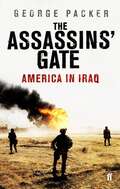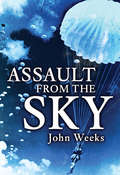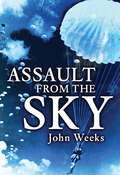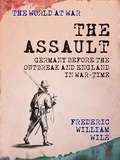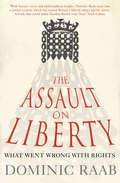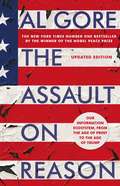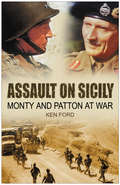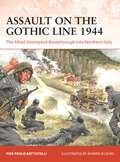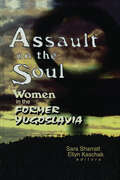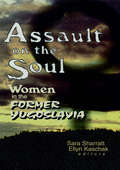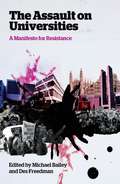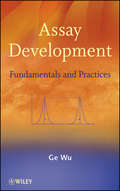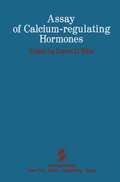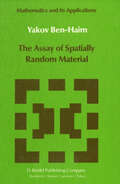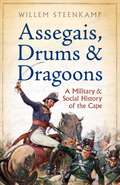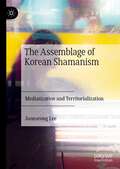- Table View
- List View
The Assassins' Gate (PDF): America in Iraq
by George PackerThe Assassins' Gate recounts how the United States set about changing the history of the Middle East and became ensnared in a guerrilla war in Iraq. The consequences of that policy are shown in the author's vivid reporting on the ground in Iraq, where he made several tours on assignment for The New Yorker. We see up close the struggles of individual American soldiers and civilians and Iraqis from all backgrounds. Here is the full range of ideas and emotions stirred up by America's most controversial foreign-policy venture since Vietnam.
Assault Brigade: The 18th Australian Infantry Brigade in World War II (Australian Army History Series)
by null Matthew MillerThe Australian Army served in numerous theatres and campaigns throughout World War II, earning distinction and at times facing significant challenges. During the Pacific War, the infantry brigade, as an intermediate formation commanding multiple infantry battalions and numerous attached units, was key in Australian efforts to secure victory. The 18th Infantry Brigade participated in a variety of combat operations with a range of allies allowing it rare experience among Australian units. It's involvement in operations from Europe to the Middle East and onto the Pacific ensured that it was one of the most modern brigades at the close of the war. Assault Brigade examines the challenges and development of the Australian Army's 18th Infantry Brigade throughout World War II. It investigates a series of campaigns fought across the South West Pacific Area, highlighting lessons learnt and adaptations implemented as a result of each battle.
Assault From the Sky: The History of Airborne Warfare 1939–1980s (Osprey Digital Generals Ser.)
by John WeeksThe introduction of Airborne forces revolutionised military tactics and thinking throughout the twentieth century. In this exciting edition, ex-paratrooper John Weeks presents a history of the Airborne forces across the globe, studying the generals, the planners and parachutists, as well as the aircraft, gliders, weapons and helicopters, alongside a look at their background and their most famous actions, such as Crete, Arnhem, D-Day and the crossing the Rhine. Within each chapter Weeks presents a detailed analyses of the main airborne forces. Airborne raids caught popular imagination from early in the Second World War, when the Germans carried out daring and alarming raids. The assault is fast and dynamic, and most of all, unpredictable, which in the early 1940s led all participants of the war to develop airborne forces of their own.
Assault From the Sky: The History of Airborne Warfare 1939–1980s (Osprey Digital Ser.)
by John WeeksThe introduction of Airborne forces revolutionised military tactics and thinking throughout the twentieth century. In this exciting edition, ex-paratrooper John Weeks presents a history of the Airborne forces across the globe, studying the generals, the planners and parachutists, as well as the aircraft, gliders, weapons and helicopters, alongside a look at their background and their most famous actions, such as Crete, Arnhem, D-Day and the crossing the Rhine. Within each chapter Weeks presents a detailed analyses of the main airborne forces. Airborne raids caught popular imagination from early in the Second World War, when the Germans carried out daring and alarming raids. The assault is fast and dynamic, and most of all, unpredictable, which in the early 1940s led all participants of the war to develop airborne forces of their own.
The Assault Germany Before the Outbreak and England in War-Time: Germany Before The Outbreak And England In War-time; A Personal Narrative (The World At War)
by Frederic WileExcerpt: "During the war I have lived in Germany, England and the United States--a week of it in Berlin, three months at different periods in America, and the rest of the time in London. My observations of Germany have not been confined to the six and a half days the Prussian police permitted me to tarry in their midst, for my work in London has dealt almost exclusively with day-by-day examination of that weird production which will be known to history as the German war-time Press. I am quite sure the perspective of the life and times of the Kaiser's people in their "great hour" was clearer from the vantage-ground of a newspaper desk near the Thames embankment than it could possibly have been had it been my lot to view the Fatherland at war as an observer writing, under the hypnotic influence of mass-suggestion, of Germany from within."
The Assault on International Law
by Jens David OhlinInternational law presents a conceptual riddle. Why comply with it when there is no world government to enforce it? The United States has a long history of skepticism towards international law, but 9/11 ushered in a particularly virulent phase of American exceptionalism, as the US drifted away from international institutions and conventions. Although American politicians and their legal advisors are often the public face of this attack, the root of this movement is a coordinated and deliberate attack by law professors hostile to its philosophical foundations, including Eric Posner, Jack Goldsmith, Adrian Vermeule, and John Yoo. In a series of influential writings, they have claimed that since states are motivated primarily by self-interest, compliance with international law is nothing more than high-minded talk. These abstract arguments provide a foundation for dangerous legal conclusions: that international law is largely irrelevant to determining how and when terrorists can be captured or killed; that the US President alone should be directing the War on Terror without significant input from Congress or the judiciary; that US courts should not hear lawsuits alleging violations of international law; and that the US should block any international criminal court with jurisdiction over Americans. These polemical accounts have ultimately triggered America's pernicious withdrawal from international cooperation. In The Assault on International Law, Jens David Ohlin exposes the mistaken assumptions of these "New Realists," in particular their impoverished utilization of rational choice theory. In contrast, he provides an alternate vision of international law based on an innovative theory of human rationality. According to Ohlin, rationality requires that agents follow through on their plans and commitments even when faced with opportunities for defection, as long as the original plan was beneficial for the agent. Seen in the light of this planning theory of rational agency, international law is the product of nation-states cooperating to escape a brutish State of Nature-a result that is not only legally binding but also in each state's self-interest.
The Assault on International Law
by Jens David OhlinInternational law presents a conceptual riddle. Why comply with it when there is no world government to enforce it? The United States has a long history of skepticism towards international law, but 9/11 ushered in a particularly virulent phase of American exceptionalism, as the US drifted away from international institutions and conventions. Although American politicians and their legal advisors are often the public face of this attack, the root of this movement is a coordinated and deliberate attack by law professors hostile to its philosophical foundations, including Eric Posner, Jack Goldsmith, Adrian Vermeule, and John Yoo. In a series of influential writings, they have claimed that since states are motivated primarily by self-interest, compliance with international law is nothing more than high-minded talk. These abstract arguments provide a foundation for dangerous legal conclusions: that international law is largely irrelevant to determining how and when terrorists can be captured or killed; that the US President alone should be directing the War on Terror without significant input from Congress or the judiciary; that US courts should not hear lawsuits alleging violations of international law; and that the US should block any international criminal court with jurisdiction over Americans. These polemical accounts have ultimately triggered America's pernicious withdrawal from international cooperation. In The Assault on International Law, Jens David Ohlin exposes the mistaken assumptions of these "New Realists," in particular their impoverished utilization of rational choice theory. In contrast, he provides an alternate vision of international law based on an innovative theory of human rationality. According to Ohlin, rationality requires that agents follow through on their plans and commitments even when faced with opportunities for defection, as long as the original plan was beneficial for the agent. Seen in the light of this planning theory of rational agency, international law is the product of nation-states cooperating to escape a brutish State of Nature-a result that is not only legally binding but also in each state's self-interest.
The Assault on Liberty: What Went Wrong With Rights
by Dominic RaabAn urgent and necessary polemic on the government’s assault on our fundamental freedoms and the proliferation of Human Rights.
The Assault on Reason: Our Information Ecosystem, from the Age of Print to the Era of Trump (Thorndike Basic Ser.)
by Al GoreNow with a New Preface and Conclusion: 'Post-Truth: On Donald Trump and the 2016 Election' The United States of America is in the midst of a deepening crisis for their democracy. After the strangest election cycle in modern American history it is important that the grave threats to the American way of life that were glaringly revealed in this campaign are addressed. In The Assault on Reason, Nobel Peace Prize winner and former Vice President Al Gore examines how faith in the power of reason – the idea that citizens can govern themselves through rational debate – is in peril. Democracy depends on a well-informed citizenry and a two-way conversation about ideas, but the public sphere has been degraded by fake news and the politics of fear, partisanship and blind faith. Now updated to investigate the rise of Trump and post-truth politics, The Assault on Reason is a farsighted and powerful manifesto for clear thinking, crucial if the vitality of democracy is to be rebuilt and good decisions made once more.
Assault on Sicily: Monty and Patton at War
by Ken FordThe campaign that defined the progress of the Second World War - and sowed the seeds of rivalry between these two key Allied commanders.
Assault on the Gothic Line 1944: The Allied Attempted Breakthrough into Northern Italy (Campaign)
by Pier Paolo BattistelliEnjoy a detailed examination of Operation Olive as US, British, Commonwealth and Allied forces seek to smash through the last German defensive line in Italy.The Italian theatre of operations post-summer 1944 was often (and incorrectly) surmised at the time as a quiet sector of World War II, populated with troops who were relieved not to find themselves fighting in North-West Europe. Yet the true nature of the hard fighting that took place here was soon revealed when the Allies began their assault on the Axis Gothic Line defences, known as Operation Olive. In this book, Italian military historian Pier Paolo Battistelli documents the dual Allied offensive spearheaded by American and British units to smash through what was supposed to be the final Axis defensive line in Italy before the Alps. The overall strategic aims of both the Axis and Allied leaders are explored, together with the organization of the forces committed.The expertly researched maps and 3D diagrams guide the reader through the progress of the phased battles in challenging terrain. Photographs and specially commissioned artworks show the soldiers that fought on both sides, including American, Canadian, Indian, Brazilian, Polish, New Zealander, British, German and Italian troops, as well as the materiel they employed. The result is an essential illustrated guide to a fascinating and complex late-war campaign.
Assault on the Gothic Line 1944: The Allied Attempted Breakthrough into Northern Italy (Campaign #387)
by Pier Paolo BattistelliEnjoy a detailed examination of Operation Olive as US, British, Commonwealth and Allied forces seek to smash through the last German defensive line in Italy.The Italian theatre of operations post-summer 1944 was often (and incorrectly) surmised at the time as a quiet sector of World War II, populated with troops who were relieved not to find themselves fighting in North-West Europe. Yet the true nature of the hard fighting that took place here was soon revealed when the Allies began their assault on the Axis Gothic Line defences, known as Operation Olive. In this book, Italian military historian Pier Paolo Battistelli documents the dual Allied offensive spearheaded by American and British units to smash through what was supposed to be the final Axis defensive line in Italy before the Alps. The overall strategic aims of both the Axis and Allied leaders are explored, together with the organization of the forces committed.The expertly researched maps and 3D diagrams guide the reader through the progress of the phased battles in challenging terrain. Photographs and specially commissioned artworks show the soldiers that fought on both sides, including American, Canadian, Indian, Brazilian, Polish, New Zealander, British, German and Italian troops, as well as the materiel they employed. The result is an essential illustrated guide to a fascinating and complex late-war campaign.
Assault on the Soul: Women in the Former Yugoslavia
by Sara SharrattAssault on the Soul: Women in the Former Yugoslavia sheds light upon women’s wartime experiences and makes sense of their coping strategies in the face of the innumerable atrocities committed against them. This is the only book to present the experiences of therapists, counselors, and other mental health professionals along with attorneys and Justices of the International Criminal Tribunal in working from both psychological and legal perspectives with women in former Yugoslavia. The workers who relate their experiences come from both former Yugoslavia and other nations, representing countries such as Norway, Germany, Holland, Costa Rica and the United States. Focusing on this region offers you a look at applied feminist practice in a cultural context outside the United States or Northern European. Assault on the Soul contains an integration of feminist theories and practice in psychology, women’s history, women’s geography, and women’s jurisprudence. This collection of articles is intended as a historical document, as assurance that both the plight of women and the role of women in bringing it to the attention of the international community and the justice system will not be erased. Assault on the Soul will help you serve your patients’needs by focusing on such issues as: feminist psychology and global issues concerning crimes against women interviews with judges for the International Criminal Tribunal Belgrade feminists’experiences working with female survivors of war supporting women’s projects in the former Yugoslavia traumatized women and the impact of a women-centered training program in Bosnia psychosocial services among refugee women during the war the victims and perpetrators of Serbia reports of rapes, killings, burning villages, and other serious war crimesAssault on the Soul gives you first-hand accounts of war trauma to women. Deeply moving and well written, the articles in this book are written in a combination of legal and psychological approaches to help you teach clients to heal from severe, acute, and chronic trauma.
Assault on the Soul: Women in the Former Yugoslavia
by Sara SharrattAssault on the Soul: Women in the Former Yugoslavia sheds light upon women’s wartime experiences and makes sense of their coping strategies in the face of the innumerable atrocities committed against them. This is the only book to present the experiences of therapists, counselors, and other mental health professionals along with attorneys and Justices of the International Criminal Tribunal in working from both psychological and legal perspectives with women in former Yugoslavia. The workers who relate their experiences come from both former Yugoslavia and other nations, representing countries such as Norway, Germany, Holland, Costa Rica and the United States. Focusing on this region offers you a look at applied feminist practice in a cultural context outside the United States or Northern European. Assault on the Soul contains an integration of feminist theories and practice in psychology, women’s history, women’s geography, and women’s jurisprudence. This collection of articles is intended as a historical document, as assurance that both the plight of women and the role of women in bringing it to the attention of the international community and the justice system will not be erased. Assault on the Soul will help you serve your patients’needs by focusing on such issues as: feminist psychology and global issues concerning crimes against women interviews with judges for the International Criminal Tribunal Belgrade feminists’experiences working with female survivors of war supporting women’s projects in the former Yugoslavia traumatized women and the impact of a women-centered training program in Bosnia psychosocial services among refugee women during the war the victims and perpetrators of Serbia reports of rapes, killings, burning villages, and other serious war crimesAssault on the Soul gives you first-hand accounts of war trauma to women. Deeply moving and well written, the articles in this book are written in a combination of legal and psychological approaches to help you teach clients to heal from severe, acute, and chronic trauma.
The Assault on the State: How the Global Attack on Modern Government Endangers Our Future
by Stephen E. Hanson Jeffrey S. KopsteinWhat if the state as we know it didn’t exist? Our air would be poisonous, our votes uncounted, and our markets dysfunctional. Yet across the world, in countries as diverse as Hungary, Israel, the U.K., and the U.S., attacks on the modern state and its workforce are intensifying. They are morphing into power grabs by self-aggrandizing politicians who attempt to seize control of the state for themselves and their cronies. What replaces the modern state once it is fatally undermined is not the free market and the flowering of personal liberty. Instead, the death of government agencies organized under the rule of law inevitably leads to the only realistic alternative: the rule of men.In the Assault on the State, political scientists Stephen Hanson and Jeffrey Kopstein offer an impassioned plea to defend modern government against those who seek to destroy it. They dissect the attack on the machinery of government from its origins in post-Soviet Russia to the core powers of Western democracy. The dangers of state erosion imperil every aspect of our lives. Kopstein and Hanson outline a strategy that can reverse this destructive trend before humanity is plunged back into the pathological personalistic politics of premodern times.
The Assault on Universities: A Manifesto for Resistance
by Michael Bailey Des FreedmanWith funding cuts well under way and many institutions already promising to charge the maximum 9,000 pounds yearly tuition fee, university education for the majority is under threat. This book exposes the true motives behind the government's programme and provides the analytical tools to fight it.*BR**BR*Widespread student protests and occupations, often supported by staff, unions and society at large, show the public's opposition to funding cuts and fee increases. The contributors to this sharp, well-written collection, many of whom are active participants in the anti-cuts movement, outline what's at stake and why it matters. They argue that university education is becoming increasingly skewed towards vocational degrees, which devalues the arts and social sciences - subjects that allow creativity and political inquiry to flourish.*BR**BR*Released at the beginning of the new academic year, this book will be at the heart of debates around the future of higher education in the UK and beyond, inspiring both new and seasoned activists in the fight for the soul of our universities.
The Assault on Universities: A Manifesto for Resistance
by Des Freedman Michael BaileyWith funding cuts well under way and many institutions already promising to charge the maximum 9,000 pounds yearly tuition fee, university education for the majority is under threat. This book exposes the true motives behind the government's programme and provides the analytical tools to fight it.*BR**BR*Widespread student protests and occupations, often supported by staff, unions and society at large, show the public's opposition to funding cuts and fee increases. The contributors to this sharp, well-written collection, many of whom are active participants in the anti-cuts movement, outline what's at stake and why it matters. They argue that university education is becoming increasingly skewed towards vocational degrees, which devalues the arts and social sciences - subjects that allow creativity and political inquiry to flourish.*BR**BR*Released at the beginning of the new academic year, this book will be at the heart of debates around the future of higher education in the UK and beyond, inspiring both new and seasoned activists in the fight for the soul of our universities.
Assay Development: Fundamentals and Practices
by Ge WuEssential principles and practice of assay development The first comprehensive, integrated treatment of the subject, Assay Development: Fundamentals and Practices covers the essentials and techniques involved in carrying out an assay project in either a biotechnology/drug discovery setting or a platform setting. Rather than attempting comprehensive coverage of all assay development technologies, the book introduces the most widely used assay development technologies and illustrates the art of assay development through a few commonly encountered biological targets in assay development (e.g., proteases, kinases, ion channels, and G protein-coupled receptors). Just enough biological background for these biological targets is provided so that the reader can follow the logics of assay development. Chapters discuss: The basics of assay development, including foundational concepts and applications Commonly used instrumental methods for both biochemical assays and cell-based assays Assay strategies for protein binding and enzymatic activity Cell-based assays High-throughput screening An in-depth study of the now popular Caliper's off-chip kinase assay provides an instructive, real-world example of the assay development process.
Assay of Calcium-regulating Hormones
by Daniel D. BikleThe ability to measure accurately the hormones regulating calcium homeosta sis is the fundamental first step toward understanding the roles these hormones play in health and disease. Techniques for such measurements have only been available for the past 10 years or so and remain in a state of rapid development. Sensitive parathyroid hormone (PTH) radioimmunoassays appeared in the early 1970s, and with them came a whole new appreciation for the prevalence and implications of hyperparathyroidism, primary or secondary, in the popu lation. The calcitonin (CT) radioimmunoassay came later and achieved rapid success in the. diagnosis of a previously poorly understood cancer, medullary carcinoma of the thyroid, frequently associated with the familial multiple endo crine neoplasia type 2 syndromes (a and b). As the sensitivity of the calcitonin radioimmunoassay has improved, our understanding of the role of calcitonin in normal physiological processes has increased. The knowledge that vitamin D must be metabolized to produce its biologic effects is only 15 years old. This has had profound implications in our understanding of a variety of metabolic bone, kidney, and gastrointestinal diseases. Assays to measure the major cir culating form of vitamin D, 25-hydroxyvitamin D, were described 10 years ago. Assays for the other metabolites, in particular, 1,25-dihydroxyvitamin D, were described even more recently. As of today, we know of many vitamin D metabolites and have developed the techniques to measure most of them; how ever, many questions remain concerning their physiological role.
The Assay of Spatially Random Material (Mathematics and Its Applications #20)
by Yakov Ben-HaimApproach your problems from the right end It isn't that they can't see the solution. It is and begin with the answers. Then one day, that they can't see the problem. perhaps you will find the final question. G. K. Chesterton. The Scandal of Father 'The Hermit Clad in Crane Feathers' in R. Brown The point of a Pin'. van Gulik's The Chinese Maze Murders. Growing specialization and diversification have brought a host of monographs and textbooks on increasingly specialized topics. However, the "tree" of knowledge of mathematics and related fields does not grow only by putting forth new branches. It also happens, quite often in fact, that branches which were thought to be completely disparate are suddenly seen to be related. Further, the kind and level of sophistication of mathematics applied in various sciences has changed drastically in recent years: measure theory is used (non trivially) in regional and theoretical economics; algebraic geometry interacts with physics; the Minkowsky lemma, coding theory and the structure of water meet one another in packing and covering theory; quantum fields, crystal defects and mathematical programming profit from homotopy theory; Lie algebras are relevant to filtering; and prediction and electrical engineering can use Stein spaces. And in addition to this there are such new emerging subdisciplines as "experimental mathematics", "CFD", "completely integrable systems", "chaos, synergetics and large-scale order", which are almost impossible to fit into the existing classification schemes. They draw upon widely different sections of mathematics.
Assegais, Drums & Dragoons: A Military And Social History Of The Cape
by Willem SteenkampWhat motivated a small multiracial force of Cape-born soldiers - whites, coloureds and Malays - to put up such stiff resistance at the Battle of Blaauwberg in 1806, in spite of odds so overwhelming that even some long-serving professional soldiers broke rank and ran? This was the intriguing question that launched author Willem Steenkamp's research. It was an investigation which eventually took him back to 150 years before Jan van Riebeeck landed at the Cape in 1652, and involved examining the social as well as the military history of the Cape. What Steenkamp discovered differs from what most South Africans think about that period, and he corrects a number of serious misconceptions not only about the soldiers of 1510-1806 but about the social and political development of the Cape. For students of the Napoleonic Wars, the book provides new information about a forgotten aspect of that conflict; for the ordinary reader here is a story no-one has ever told before in its entirety. Assegais, Drums and Dragoons: A Military and Social History of the Cape is a well-researched and fascinating account that now illuminates a previously lightless corner of South African military history Descended from a 1690s-era solider, Willem Steenkamp is a writer, journalist and specialist tour guide who has also been a solider, a security advisor and a director of military tattoos and other spectacles, among several other things. Since childhood he has been absorbing the Cape's history from family stories (one of his ancestors was a hero of the Battle of Blaauwberg) and voluminous reading. And yes, he actually has fired flintlock muskets and muzzle-loading cannon. Willem lives in Cape Town.
Assekuranz, Ökologie und Risiko: Versicherungen als Mitgestalter des ökologischen Generationenvertrages (DUV Wirtschaftswissenschaft)
by Reiner WiedenlübbertDer Autor untersucht das Spannungsdreieck von Assekuranz, Ökologie und Risiko und kommt zu dem Ergebnis, dass die Versicherungswirtschaft den "ökologischen Generationenvertrag" aktiv mitgestalten sollte.
Assemblage, Enactment, and Agency: Educational policy perspectives
by Melody Viczko Augusto RiverosAssemblage, Enactment, and Agency offers an exploration of the emerging shift in policy research towards the notion of policy enactment, namely, the creative recontextualization and translation of policy ideas into social realities by policy actors in education. Bringing together recent work on the intersections between assemblages, enactments, and agencies in educational policy analysis, the authors call attention to issues of subjectivity, practice, power, and relationality as they offer critical perspectives that challenge linear/instrumentalist views of policy processes. In doing so, they not only interrogate conventional understandings of policy design, implementation, and evaluation, they also recognize the role of agency, interpretation, sense-making, translation, embodiment, and meaning throughout policy processes. They also explore the contested nature of policy, situating educational policies as sites of conflict and negotiation between actors, highlighting the uncertainty, fragility and instability of policy work. By offering a non-linear and heterogeneous account of education policy, the collection furthers contemporary conversations on the nature and goals of education reform. This book was originally published as a special issue of Discourse: Studies in the Cultural Politics of Education.
Assemblage, Enactment, and Agency: Educational policy perspectives
by Melody Viczko Augusto RiverosAssemblage, Enactment, and Agency offers an exploration of the emerging shift in policy research towards the notion of policy enactment, namely, the creative recontextualization and translation of policy ideas into social realities by policy actors in education. Bringing together recent work on the intersections between assemblages, enactments, and agencies in educational policy analysis, the authors call attention to issues of subjectivity, practice, power, and relationality as they offer critical perspectives that challenge linear/instrumentalist views of policy processes. In doing so, they not only interrogate conventional understandings of policy design, implementation, and evaluation, they also recognize the role of agency, interpretation, sense-making, translation, embodiment, and meaning throughout policy processes. They also explore the contested nature of policy, situating educational policies as sites of conflict and negotiation between actors, highlighting the uncertainty, fragility and instability of policy work. By offering a non-linear and heterogeneous account of education policy, the collection furthers contemporary conversations on the nature and goals of education reform. This book was originally published as a special issue of Discourse: Studies in the Cultural Politics of Education.
The Assemblage of Korean Shamanism: Mediatization and Territorialization
by Joonseong LeeThe most unique aspect of Korean shamanism is its mysterious duality that continually reiterates the processes of deterritorialization and reterritorialization. This book approaches that puzzle of mysterious duality using an interdisciplinary lens. Korean shamanism has been under continuous oppression and marginalization for a long time, and that circumstance has never dissipated. Shaman culture can be found in every corner of people’s lives in contemporary Korea, but few acknowledge their indigenous beliefs with pride. This mysterious duality has deepened as the mediatization process of Korean shamanism has developed. Korean shamanism was revived as the dynamic of shamanic inheritance in the process, but these dynamics have also become the object of mockery. For this reason, any true understanding of Korean shamanism rests in how to unravel the unique puzzles of this mysterious duality. In this book, the duality is mapped out by playing with the puzzles surrounding the contextualization of Korean shamanism and mediatization.
